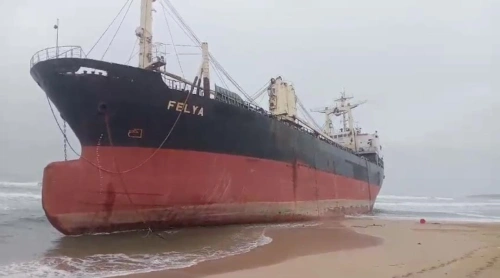Cargo Ship Felya Runs Aground Amid Fierce Storms Off Ujung Kulon. Battling fierce seas and relentless winds, the cargo vessel Felya—with a Gross Tonnage of 6,306 and Call Sign YEEU—ran aground in the treacherous waters near Ujung Kulon after a series of dramatic events triggered by extreme weather.

The ordeal began on December 1, 2024, when Felya anchored at coordinates 06°50.9525’S – 105°22.944’E, resting at a depth of 30 meters. The crew was waiting for a tugboat to tow the ship to Merak Port for urgent repairs to its leaking propeller shaft.
But nature had other plans. Powerful westerly winds, howling at 35–40 knots, caused the ship to pitch violently. By 7:00 PM local time, the captain’s worst fears came true: radar and GPS showed Felya drifting dangerously off position. The crew scrambled to deploy the starboard anchor, fighting to halt the drift as the storm grew stronger.
Dragged by the Storm
By December 4, the weather had turned ferocious. Westerly winds roared even harder, and waves towered up to 4 meters high. The anchors could no longer hold. Pushed by the relentless sea, Felya drifted helplessly until it finally ran aground at 06°51.460’S – 105°30.230’E at 4:00 PM.
Sensing the threat to his crew, the captain wasted no time. He ordered everyone to brace for an “abandon ship” procedure—an order no sailor wants to hear, but one that would save their lives.
Stranded with Dwindling Supplies
For two tense days, the crew endured hunger and exhaustion as food supplies ran low. Although the company had arranged a supply run, rough seas with 4–5 meter waves kept rescue boats at bay.
Then, on December 4 at 4:30 PM, as conditions worsened, the evacuation began in earnest. Wearing life jackets and flotation devices, the crew lowered themselves off the stranded vessel using ropes fastened to the shore. Local fishermen braved the waves to help bring the sailors to safety—a testament to the courage and solidarity of coastal communities. By 6:00 PM, all crew members were safe on land.
Rescue and Recovery
Two days later, on December 6 at 8:00 PM, a rescue team from Pangkalan PLP Class I Tanjung Priok and KUPP Class III Labuhan reached the scene. They were met by the Head of Ujung Kulon National Park, local village leaders, and Felya’s captain. Of the 18 crew members, all were found safe and healthy, except one engineer who needed further treatment at RSUD Serang after initial care at a local clinic.
This incident serves as a stark reminder of the perils seafarers face—especially when navigating in extreme weather conditions. Authorities and conservationists now hope that salvage operations can proceed swiftly, minimizing any threat to Ujung Kulon’s protected coastline and precious marine life. Source: Dephub
More About Cargo Ship Felya
Specification:
- Name: MV Felya
- Gross Tonnage (GT): 6,306 GT — this figure refers to the ship’s overall internal volume and is a standard measure of the vessel’s size.
- Call Sign: YEEU — this is the unique radio identifier used for communication and tracking.
- Primary Role: General cargo transport — though your article does not specify what cargo Felya was carrying at the time of the incident, vessels of this size typically carry bulk goods, containers, or general cargo.
- Recent Status: As of December 2024, Felya was waiting for repairs to fix a leaking propeller shaft when it ran aground near Ujung Kulon due to severe weather.
A ship of this tonnage is usually about 100–140 meters long (this is an estimate, as the actual length depends on its design). Cargo ships of this class often operate on coastal or regional shipping routes, transporting goods between major ports.
They typically have:
- One or more cargo holds for dry bulk or break-bulk cargo.
- A single propeller shaft driven by a main engine, which can develop significant thrust but is vulnerable if the shaft leaks or fails.
- A standard crew of around 15–25 people, depending on automation and voyage length.
Operational Risks
- Ships like Felya are subject to various operational hazards:
- Mechanical failures (like a leaking shaft) can limit maneuverability, making them more vulnerable during bad weather.
- Extreme weather can overpower anchoring systems, especially if winds reach 35–40 knots and waves rise to several meters.
Environmental stakes are high if they run aground near sensitive coastal or marine ecosystems—like Ujung Kulon National Park, which is a UNESCO World Heritage Site and home to rare species like the Javan rhino.
Next Steps for Felya
- After running aground, the vessel would likely need:
- Salvage operations to refloat and tow it to port.
- Inspections for hull damage.
- Repairs to its propulsion system.
- Environmental checks to ensure there are no oil spills or other contamination risks to the protected area.




